#simcenter 3d
Explore tagged Tumblr posts
Text
Siemens Simcenter 3D: Empowering Simulation Teams with Flexible CAE Licensing
Simcenter 3d: Enjoy Flexible CAE Licensing
Siemens' Simcenter 3D stands out for its commitment to providing flexibility and efficiency to simulation teams. One key aspect contributing to this adaptability is Simcenter 3D's innovative approach to licensing, introducing a value-based token licensing system.
Unlike the traditional model of purchasing individual licenses for each add-on module, Simcenter 3D's token licensing offers a more versatile and cost-effective solution. With this approach, users have the option to acquire packs of tokens, providing instant access to a wide range of Simcenter 3D modules.
The shift to a token-based licensing system brings several advantages to simulation teams:
Cost Efficiency: Token licensing eliminates the need for individual module licenses, allowing teams to optimize costs by acquiring token packs based on their specific needs. This approach provides a cost-effective solution, particularly for teams requiring access to multiple Simcenter 3D modules.
Flexibility and Instant Access: The token system enhances flexibility, enabling teams to allocate resources based on project requirements. This approach is particularly advantageous for dynamic project environments where the demand for specific modules may vary. With token packs, teams can instantly access the required modules without the constraints of traditional licensing models.
Streamlined Collaboration: Simcenter 3D's token licensing promotes collaboration by offering a shared pool of tokens that team members can draw from. This ensures that resources are utilized efficiently across the team, facilitating seamless collaboration on diverse simulation projects.
Scalability: As simulation needs evolve and projects expand, Simcenter 3D's token licensing system provides scalability. Teams can easily scale their simulation capabilities by acquiring additional token packs, aligning with the growth and changing demands of their projects.
Simplified Management: Managing Simcenter 3D licenses becomes more straightforward with token-based licensing. Teams can streamline the allocation and usage of tokens, making it easier to track and manage resources effectively.
To sum up, Simcenter 3D licensing introduces a new level of adaptability and cost efficiency for simulation teams. By moving away from traditional licensing models, Simcenter 3D empowers teams to optimize resources, enhance collaboration, and scale their simulation capabilities seamlessly. In a field where flexibility and efficiency are paramount, Simcenter 3D's approach to licensing reaffirms its commitment to meeting the evolving needs of simulation engineers.
To get a free Siemens Simcenter 3d License trial, reach out to Simulation Experts!
#siemens cae#caesoftware#cae#siemens cae software#simcenter 3d#simulation software#free cae software#siemens simulation software#siemens simcenter 3d software
0 notes
Text
Siemens Simcenter 3D Low Frequency EM 2020.1 for NX Lifetime
Siemens Simcenter 3D Low Frequency EM 2020.1 for NX Lifetime License. Siemens Simcenter 3D Low Frequency Electromagnetics (EM) 2020.1 for NX is a specialized module within the Simcenter 3D suite that provides powerful simulation tools for analyzing low-frequency electromagnetic fields. This software is essential for engineers and designers working on products and systems where low-frequency…
0 notes
Text
Score big this March with PROLIM's Software Sale! Buy one cutting-edge product, get the second at 50% OFF. Elevate your design process with Solid Edge, NX, Teamcenter, and Simcenter 3D. Every purchase enters you to WIN tickets to a March Madness game! Don't miss out!
To Explore more - http://www.prolim.com/
#ThinkPROLIM#DigitalTransformation#TodayMeetsTomorrow#PLMSolutions#PROLIMMarchMadness#SoftwareSale#TechDeal#DesignInnovation
0 notes
Video
tumblr
Stimulating Robot Performance
The demand for robots continues to grow at a rapid pace. But what might be even more impressive is the demand for the different types of actions and capabilities that customers want their robots to perform. How can we push those systems to their physical limits, while ensuring durability and safety? Simulation models of the complete robotic system help to ensure safe and lasting operation, taking into account all relevant aspects of robot operations, and Simcenter 3D can help you streamline your engineering toolchain for robot simulation.
For more information, contact us at [email protected]
0 notes
Text
Siemens Simcenter Star CCM 2.0.15 2019 Download
Siemens Simcenter Star CCM 2.0.15 2019 Download
Siemens Simcenter Star CCM 2.0.15 Torrent Download 2019 This unique construct supports Technical Data Package requirements by providing ISO standard definitions for 3D and 2D date with no translation requirement if JT data already exists. Siemens Simcenter Star CCM Portable Use the iOS and Android app offerings to visualize 3D JT files using features such as Zoom, Pan, and Rotate. Siemens…
View On WordPress
0 notes
Text
Virtual Sensors Market Size Worth $1.4 Billion By 2025 | CAGR: 27.2% | Global and Regional Forecast | Grand View Research, Inc.

The global virtual sensors market size is expected to reach USD 1.4 billion by 2025, expanding at a CAGR of 27.2%, according to a new report by Grand View Research, Inc. Growing use of virtual sensors in the human activity recognition and in the healthcare domain is driving the market. Implementation of cloud platforms integrated with IoT applications is driving the market growth.
A virtual sensor is expected to achieve multiple objectives built for a specific purpose and result in a meta-analysis about its environment. These circuits can range from very simple to very complex design and undergo changes to produce a desired output. The device is an intangible form of sensor which is activated via two kinds of input, one from user and other from physical sensor. However, virtual sensors, in terms of capabilities are much beyond physical devices that can work individually and collectively irrespective of their physical counterparts.
Trends such as new product launches and agreements are likely to be witnessed in the market. In order to enhance industrial facilities, GE offers virtual sensors to reliantly work on predix, which is a cloud-based platform mainly used in the industrial space. Moreover, Siemens AG is working on digital twin technology for the development of virtual sensing solution for its customers. Siemens AG has developed Simcenter solution that is combining the system simulation and 3D CAE for predicting the performance parameters earlier and throughout the product lifecycle.
The solutions segment is expected to witness largest virtual sensors market share over the forecast period. This is attributed to advent of industry 4.0 and rising demand for cloud-based solutions in the manufacturing facilities. Such solutions are anticipated to promote the robot guidance operations by sensing and reducing accidents.
The market in Asia Pacific offers lucrative growth opportunities in terms of technology output, competitive advantage, and relevancy. In addition, the market witnesses a high influx of investments by stakeholders in various verticals pertaining to product development. Compliance policies and government regulations are pivotal in creating a sustainable market development. North America is expected to hold largest market share over the forecast period. This is attributed to rising demand for IoT cloud models and continuous innovations in the field of VR. In addition, growing adoption of advanced technologies among the companies in the region is driving the market growth.
Browse Full Report (Tables & Figures) @ https://www.grandviewresearch.com/industry-analysis/virtual-sensors-market
Contact Us:
Grand View Research, Inc. 201 Spear Street 1100, San Francisco, CA 94105 United States
Phone:
1-415-349-0058
Toll Free:
1-888-202-9519
Email:
0 notes
Text
Virtual Sensors Market Size Volume, Share, Demand growth, Business Opportunity by 2025
The global virtual sensors market size is expected to reach USD 1.4 billion by 2025, expanding at a CAGR of 27.2%, according to a new report by Grand View Research, Inc. Growing use of virtual sensors in the human activity recognition and in the healthcare domain is driving the market. Implementation of cloud platforms integrated with IoT applications is driving the market growth.
A virtual sensor is expected to achieve multiple objectives built for a specific purpose and result in a meta-analysis about its environment. These circuits can range from very simple to very complex design and undergo changes to produce a desired output. The device is an intangible form of sensor which is activated via two kinds of input, one from user and other from physical sensor. However, virtual sensors, in terms of capabilities are much beyond physical devices that can work individually and collectively irrespective of their physical counterparts.
Trends such as new product launches and agreements are likely to be witnessed in the market. In order to enhance industrial facilities, GE offers virtual sensors to reliantly work on predix, which is a cloud-based platform mainly used in the industrial space. Moreover, Siemens AG is working on digital twin technology for the development of virtual sensing solution for its customers. Siemens AG has developed Simcenter solution that is combining the system simulation and 3D CAE for predicting the performance parameters earlier and throughout the product lifecycle.
The solutions segment is expected to witness largest virtual sensors market share over the forecast period. This is attributed to advent of industry 4.0 and rising demand for cloud-based solutions in the manufacturing facilities. Such solutions are anticipated to promote the robot guidance operations by sensing and reducing accidents.
The market in Asia Pacific offers lucrative growth opportunities in terms of technology output, competitive advantage, and relevancy. In addition, the market witnesses a high influx of investments by stakeholders in various verticals pertaining to product development. Compliance policies and government regulations are pivotal in creating a sustainable market development. North America is expected to hold largest market share over the forecast period. This is attributed to rising demand for IoT cloud models and continuous innovations in the field of VR. In addition, growing adoption of advanced technologies among the companies in the region is driving the market growth.
View detailed insights @ https://bit.ly/3BbqSCM
Virtual Sensors Market Report Highlights
· The service segment is anticipated to witness higher growth owing to growing training and consulting activities for imparting significant knowledge and advantages of virtual sensors
· The cloud deployment segment is expected to witness a steady market growth, which can be attributed to the rise in use of IoT approach
· The aerospace and defense segment is accelerating the product demand for enhancing the passenger’s safety and safer flight operations
· The key players in the virtual sensors market are Siemens AG, General Electric Company; Aspen Technologies, Inc.; Elliptic Laboratories A/S; and Tactile Mobility.
Get Sample PDF Copy @ https://bit.ly/3E9XONY
#Virtual Sensors Market#Virtual Sensors Industry#Virtual Sensors Market Growth#Virtual Sensors Market Analysis#Virtual Sensors Market Forecast#Virtual Sensors Market Size#Virtual Sensors Market Share#Virtual Sensors Market Report#Virtual Sensors Market Research#Virtual Sensors Market Outlook#Virtual Sensors Market Segmentation#Virtual Sensors Market To 2025
0 notes
Text
Virtual Sensors Market Projected To Show Considerable Growth By 2025
The global virtual sensors market size is expected to reach USD 1.4 billion by 2025, expanding at a CAGR of 27.2%, according to a new report by Grand View Research, Inc. Growing use of virtual sensors in the human activity recognition and in the healthcare domain is driving the market. Implementation of cloud platforms integrated with IoT applications is driving the market growth.
A virtual sensor is expected to achieve multiple objectives built for a specific purpose and result in a meta-analysis about its environment. These circuits can range from very simple to very complex design and undergo changes to produce a desired output. The device is an intangible form of sensor which is activated via two kinds of input, one from user and other from physical sensor. However, virtual sensors, in terms of capabilities are much beyond physical devices that can work individually and collectively irrespective of their physical counterparts.
Trends such as new product launches and agreements are likely to be witnessed in the market. In order to enhance industrial facilities, GE offers virtual sensors to reliantly work on predix, which is a cloud-based platform mainly used in the industrial space. Moreover, Siemens AG is working on digital twin technology for the development of virtual sensing solution for its customers. Siemens AG has developed Simcenter solution that is combining the system simulation and 3D CAE for predicting the performance parameters earlier and throughout the product lifecycle.
The solutions segment is expected to witness largest virtual sensors market share over the forecast period. This is attributed to advent of industry 4.0 and rising demand for cloud-based solutions in the manufacturing facilities. Such solutions are anticipated to promote the robot guidance operations by sensing and reducing accidents.
The market in Asia Pacific offers lucrative growth opportunities in terms of technology output, competitive advantage, and relevancy. In addition, the market witnesses a high influx of investments by stakeholders in various verticals pertaining to product development. Compliance policies and government regulations are pivotal in creating a sustainable market development. North America is expected to hold largest market share over the forecast period. This is attributed to rising demand for IoT cloud models and continuous innovations in the field of VR. In addition, growing adoption of advanced technologies among the companies in the region is driving the market growth.
To request a sample copy or view summary of this report, click the link below: www.grandviewresearch.com/industry-analysis/virtual-sensors-market
Further key findings from the report suggest:
The service segment is anticipated to witness higher growth owing to growing training and consulting activities for imparting significant knowledge and advantages of virtual sensors
The cloud deployment segment is expected to witness a steady market growth, which can be attributed to the rise in use of IoT approach
The aerospace and defense segment is accelerating the product demand for enhancing the passenger’s safety and safer flight operations
The key players in the virtual sensors market are Siemens AG, General Electric Company; Aspen Technologies, Inc.; Elliptic Laboratories A/S; and Tactile Mobility.
Grand View Research has segmented the global virtual sensors market based on component, deployment, end use, and region:
Virtual Sensors Component Outlook (Revenue, USD Million, 2014 - 2025)
Solution
Service
Virtual Sensors Deployment Outlook (Revenue, USD Million, 2014 - 2025)
Cloud
On-premise
Virtual Sensors End-use Outlook (Revenue, USD Million, 2014 - 2025)
Oil & Gas
Automotive & Transportation
Manufacturing & Utilities
Electronics
Healthcare
Aerospace & Defense
Others
Virtual Sensors Regional Outlook (Revenue, USD Million, 2014 - 2025)
North America
Europe
Asia Pacific
Latin America
Middle East & Africa
U.S.
Canada
Germany
U.K.
China
India
Japan
Brazil
About Grand View Research
Grand View Research, Inc. is a U.S. based market research and consulting company, registered in the State of California and headquartered in San Francisco. The company provides syndicated research reports, customized research reports, and consulting services. To help clients make informed business decisions, we offer market intelligence studies ensuring relevant and fact-based research across a range of industries, from technology to chemicals, materials and healthcare.
0 notes
Text
Computer Aided Engineering (CAE): Siemens Simcenter 3D
In the landscape of Computer-Aided Engineering software solutions in Canada, Siemens stands out as a trailblazer with its Simcenter 3D—a robust and comprehensive suite catering to the diverse needs of CAE experts across the nation.
Canadian CAE experts seek cutting-edge solutions to tackle complex engineering challenges, and Siemens' CAE software portfolio, particularly Simcenter 3D, emerges as a powerful toolset designed to address these demands. Simcenter 3D integrates simulation, testing, and analysis capabilities into a unified platform, offering a holistic approach to engineering simulation.
Siemens' dedication to advancing CAE software in Canada is evident through Simcenter 3D's versatile functionalities. It enables engineers and analysts to simulate various scenarios across multiple disciplines such as structural, thermal, fluid dynamics, and electromagnetics. This breadth of simulation capabilities empowers users to optimize designs, predict performance, and validate product behavior with unparalleled accuracy.
The expertise of Canadian CAE professionals finds a natural fit with Siemens' CAE software, leveraging Simcenter 3D's intuitive interface and powerful simulation tools. From automotive to aerospace, manufacturing to energy sectors, Simcenter 3D's adaptability addresses industry-specific challenges, allowing CAE experts to streamline workflows and drive innovation.
Siemens' commitment to fostering a collaborative ecosystem further enhances the appeal of Simcenter 3D among CAE experts in Canada. The software's seamless integration with other Siemens solutions and third-party applications facilitates data exchange, enabling a unified engineering environment for improved efficiency and informed decision-making.
Moreover, Siemens' CAE software offerings extend beyond mere simulation tools; they embody a vision for the future of engineering. The incorporation of cutting-edge technologies such as artificial intelligence and machine learning into Simcenter 3D showcases Siemens' commitment to staying at the forefront of technological innovation, empowering Canadian CAE experts to explore new frontiers in engineering simulation.
As CAE experts in Canada navigate the complexities of engineering challenges, Siemens' Simcenter 3D remains a beacon of excellence, offering not just a suite of powerful CAE tools but a strategic partnership aimed at driving innovation, optimizing designs, and propelling businesses towards success in the dynamic landscape of engineering simulation. With Siemens CAE software, including Simcenter 3D, Canadian CAE experts find themselves equipped with the tools and support necessary to tackle the most intricate engineering puzzles and transform concepts into reality.
#caesoftware#cae#siemens cae software#CAE Experts in Canada#CAE Experts#Siemens CAE#Simcenter 3d#SImcenter 3d price
0 notes
Text
Siemens Simcenter MAGNET Suite 2021.1 Lifetime License
Siemens Simcenter MAGNET Suite 2021.1 Lifetime License. Siemens Simcenter MAGNET Suite 2021.1 is a comprehensive simulation solution designed for the analysis and design of electromagnetic and electromechanical devices. This suite provides advanced capabilities for 2D and 3D electromagnetic field simulation. Enabling engineers to optimize the performance, efficiency, and reliability of electrical…
0 notes
Text
Correlating Simulation & Modal Test Results with Simcenter 3D
Quick Overview
youtube
A powerful way of reducing design conservatism is to validate the finite element model used to simulate its performance. Comparing the simulation model’s natural frequencies and mode shapes with those acquired in test generates confidence in the model’s ability to represent the as-built structure. This in turn allows analysts to reduce the safety factors used to compute structural margins of safety. Simcenter 3D FE Model Correlation supports both test and simulation engineers who wish to perform such a comparison, efficiently providing both visual and quantitative feedback.
Background
The Modal Assurance Criterion (MAC) is a parameter indicating the degree of consistency between a mode shape from test and another one from simulation. This parameter is a scalar value between 0 and 1: A MAC value near 1 indicates a high degree of correlation or consistency between two mode shapes.
Suppose {ΨA} and {ΨX} are two mode shapes that you want to compare: Their MAC is expressed as follows:
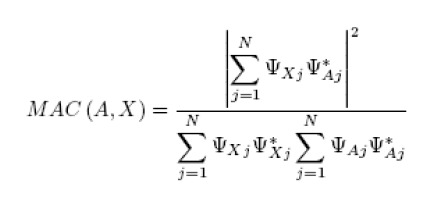
Where:
N is the number of common simulation and test mode shape components
The superscript * indicates the complex conjugate value.
There are LA x LX MAC numbers for given mode shape matrices [ΨA] and [ΨX], where LA is the number of mode shapes in [ΨA] and LX is the number of mode shapes in [ΨX]. These are presented in matrix format:
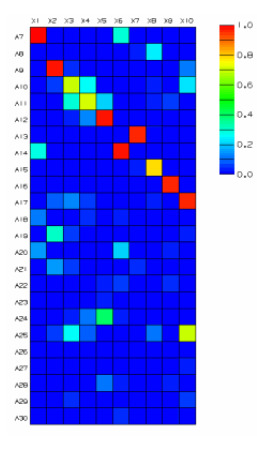
Problem Definition
We wish to compare the natural frequencies and mode shapes of an aircraft engine nacelle finite element model with the equivalent data acquired during a modal test of the actual structure:

The model and test article both represent half the nacelle.
1. Normal Modes Solution
First we create an NX Nastran normal modes solution, requesting the first 20 free-free (unconstrained) modes of the FEM. The first 6 modes describe rigid body motion, in which the structure moves without any internal strain. The next 14 modes are elastic modes, which are the ones we are interested in correlating.
In the simulation navigator, select the top-most sim node and right-click New Solution

The Solution dialog pops up. Enter a Name and as Solution Type, select Sol 103 Real Eigenvalues from the list
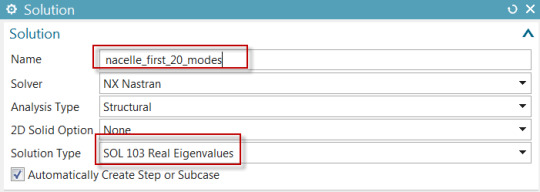
In the Case Control tab of the Solution dialog, next to Lanczos data click Create Modeling Object
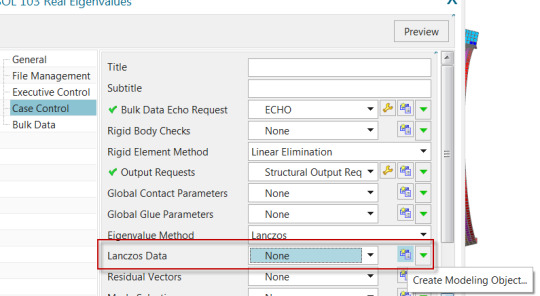
In the Real Eigenvalues Lanczos dialog, enter 20 as the Number of Desired Modes. Click OK twice.
In the sim navigator, select the solution, right-click, Solve

After the solution is complete, the mode shapes can be displayed from the post navigator.
2. Import Test Geometry and Results
In the Correlation tab of the Simcenter 3D ribbon, click New Test Reference Solution
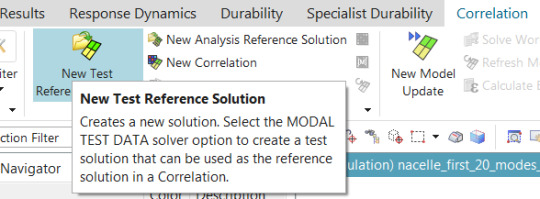
Set the Solution Type to Modal Test Data, and then select a Geometry File which contains the test geometry (test sensors, coordinate systems and traces) as well as a Modes File containing the test mode shapes and natural frequencies. In this case, the same file contains both the geometry and the mode shapes.

Click OK. There are now 2 solutions in the sim file.
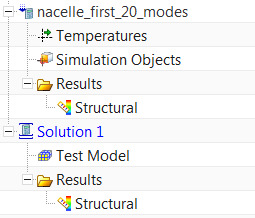
Since Solution 1 is active and points to imported geometry, the fem is now displayed as monotonic grey.
3. Align the Test Model
In the sim navigator, under Solution 1, select the Test Model node, and right-click Show Model.

You can also click Show Sensors, to see the individual sensors as triads.
It is clear that the test model and the FEM do not share the same global coordinate system. The test model will have to be aligned with the FEM in order for correlation to be possible.
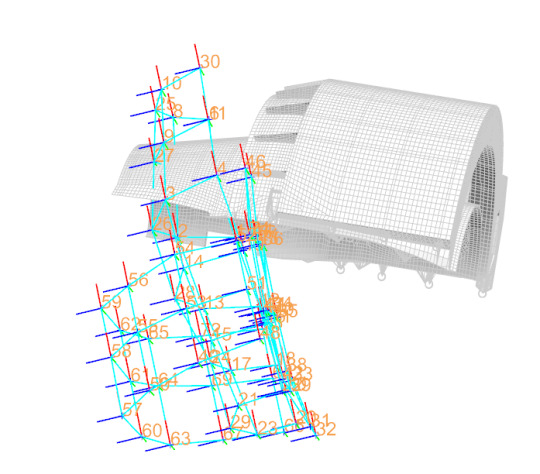
In the sim navigator, under Solution 1, select the Test Model node, and right-click Alignment. The Alignment Control dialog will appear, allowing you to choose 3 test nodes and the equivalent 3 nodes in the FEM. Checking on Preview allows you to see the cumulative effect of the pairs you have selected.

You may need to repeat this step if it is not clear which test sensors correspond to which nodes. After you have successfully performed the alignment, you may select Fine Tune Alignment to further nudge the test model by specifying discrete translations and rotations.
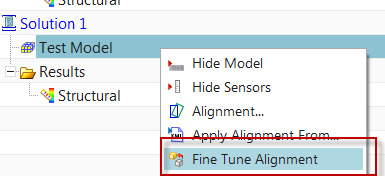
4. Create a Correlation
In the Correlation tab of the Simcenter 3D ribbon, click New Correlation
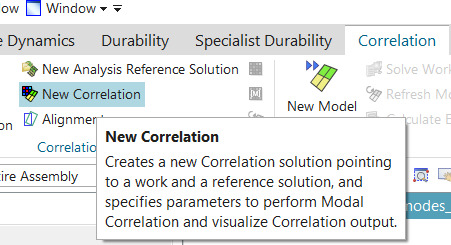
The Correlation dialog appears. Select test Solution 1 as the Reference Solution, and your normal modes solution as the Work Solution
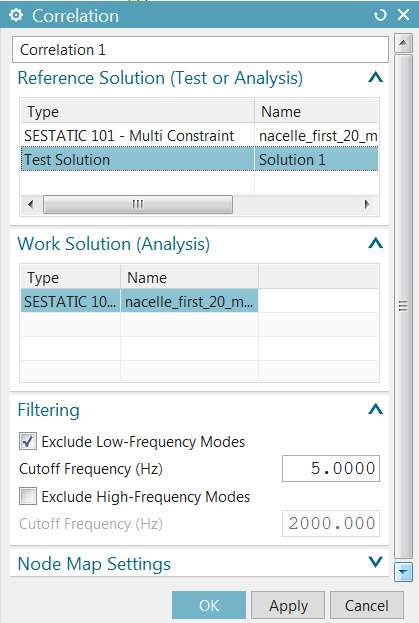
By default, low-frequency (rigid-body) modes are filtered out. In the Node Map Settings group, enter 75 mm as the matching tolerance between the test sensors and the FEM nodes. Click OK.
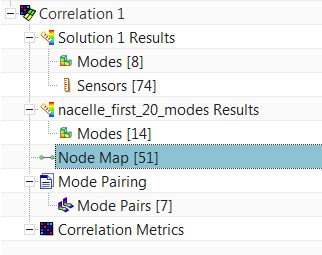
Based on the alignment that was performed, and the tolerance entered in the last step, Simcenter FE Model Correlation was able to map 51 sensors to the FE model nodes, based on proximity. If you repeat the alignment and choose different alignment node pairs, you will see a different number of paired nodes in brackets. The test and analysis mode shapes will be interrogated at these 51 locations to determine the MAC.
Next, select the Mode Pairing node under Correlation 1, right-click Edit. The default mode pairing criterion is MAC with a minimum value of 0.7: This means that test and analysis modes having the greatest MAC value above 0.7 will be paired, others will not be paired. For example, work (analysis) mode 12 is not paired to any test mode.
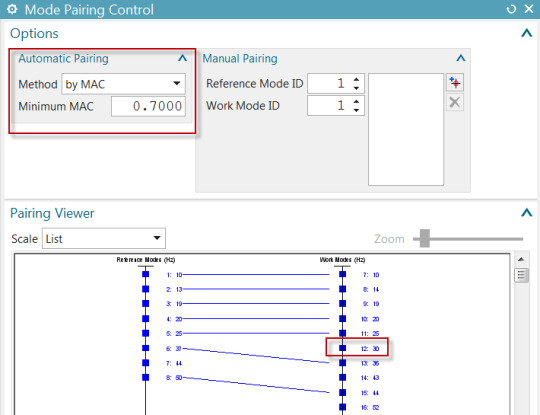
Other pairing methods can be selected.
Next, select the Mode Pairs (n) node under the Mode Pairing node and click the Correlation Details View bar

This pops up the Correlation Details View, which shows the test (reference) and analysis (work) frequencies, percent frequency error and MAC, for each mode pair.
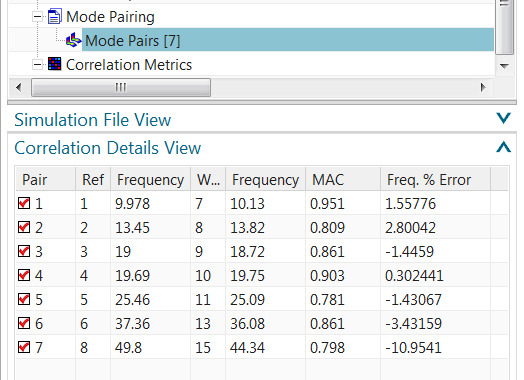
Select any mode pair row in the table, right-click Side-by-Side Animation:
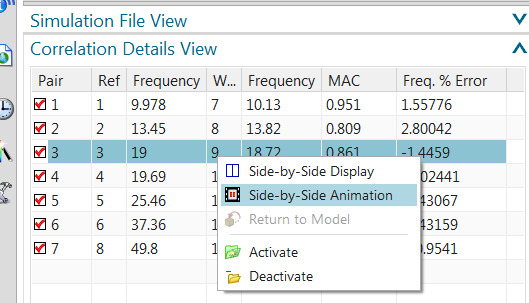
This will bring up a synchronized 2-view layout, showing the test and analysis mode shape animation
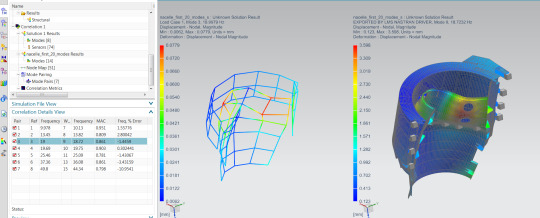
Select the Correlation Metrics node under Correlation 1, right-click Correlate. In the Correlate dialog, click Show Results Heat Map
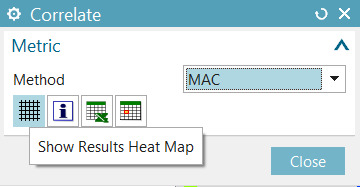
The heat map display shows the MAC matrix

In the Correlate dialog, click Show Results Spreadsheet
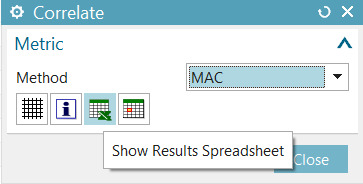
SC FE Model Correlation will send the MAC matrix to an Excel spreadsheet.
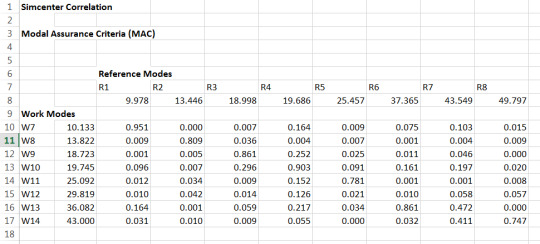
Select the Correlation Metrics node under Correlation 1, right-click Generate 1-COMAC Results.

This will show sensors at which the individual MAC components are poorest.
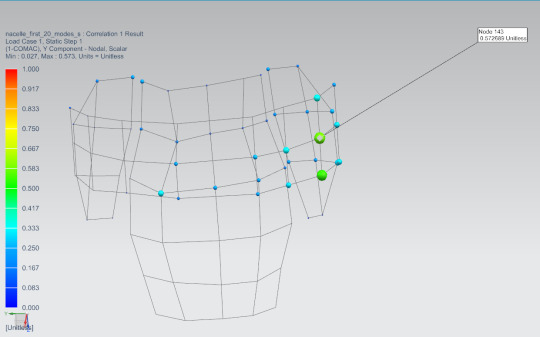
5 notes
·
View notes
Text
5 Postdoctoral Positions on Modelling, Testing and Inspection of 3D Printed Materials and Composites in Belgium, 2019
The research group “Mechanics of Materials and Structures” at Ghent University is looking for 5 postdoctoral research fellows in the fields of modelling and testing of 3D printed materials and composites. Each vacancy is a full-time position for 3 years.
All vacancies are available in the “Mechanics of Materials and Structures” research group at Ghent University. The offices and laboratories of this group are situated in the south of Ghent (Technologiepark-Zwijnaarde 903, 9052 Zwijnaarde).
The Ghent University is a top 100 university and one of the major universities in Belgium. Our 11 faculties offer a wide range of courses and conduct in-depth research in both exact and social sciences. Ghent University aims to encourage its students to adopt a critical approach within a creative, development-oriented educational and research environment.
Advertisements
Scholarship Description
Applications Deadline: Feb 28, 2019
Course Level: Scholarship is available to study postdoctoral programme.
Study Subject:
Postdoctoral vacancy (3 years) on patient-specific design and finite element modelling of 3D printed medical implants.
Postdoctoral vacancy (3 years) on automated software workflow for medical application of 3D printed technologies.
Postdoctoral vacancy (2.5 years) on multi-axial fatigue modelling and testing for 3D printed metal parts.
Postdoctoral vacancy (3 years) on modelling interfacial debonding of short fibre-reinforced composites.
Postdoctoral or PhD vacancy (3 years) on non-destructive inspection of 3D printed metal parts using ultrasound.
Nationality: Scholarship is available for students of Belgium.
Number of Scholarships: Numbers not given
Scholarship can be taken in Belgium
Eligibility for the Scholarship
Eligible Countries: Scholarship is available for students of Belgium. Entrance Requirements: Applicants must meet the following criteria:
Only candidates with a PhD degree or equivalent experience should apply. The candidate should have a strong background in design and FE modelling for medical applications. He/she will closely work together with the other postdoc in the team (see another vacancy) and is willing to travel frequently to meet and discuss with the other project partners in the neighbouring countries.
Only candidates with a PhD degree or equivalent experience should apply. The candidate should have strong programming skills (Python, C++, C#,…) and has experience with different software tools for patient-specific design of implants, for example: (i) medical image segmentation software (Mimics, SimpleWare, Amira,…), (ii) FE tools (Abaqus, Ansys, Simcenter,…), (iii) topology optimization (Autodesk Within Medical, Altair/Optistruct, Frustum/Generate,…). He/she will closely work together with the other postdoc in the team (see another vacancy) and is willing to travel frequently to meet and discuss with the other project partners in the neighbouring countries.
Only candidates with a PhD degree or equivalent experience should apply. The candidate should have a strong background in fatigue life prediction for metals (e.g. critical plane approaches) and have experimental experience with fatigue testing. Experience in the simulation of AM metals is recommended.
Only candidates with a PhD degree should apply. The candidate should have a relevant background in computational mechanics of materials, preferably combined with experience in Mean Field Homogenization methods or variational methods.
Application Procedure
How to Apply: You write a detailed Curriculum Vitae in Dutch or English, containing:
Your personal details (name, address, date of birth, nationality,…)
Your education, subject of master thesis and degrees
Your work experience (previous jobs)
Additional skills (finite element software, programming languages, communication skills, …)
Mastered languages (Dutch, English, French)
References (previous projects in the domain, published papers,…)
You send the C.V. by post or e-mail to the following person:
Scholarship Link
Advertisements
Post navigation
Need Scholarship Help? Comment and Discuss.
Advertisements
Featured Scholarships
Free Online Courses (MOOC)
Source: https://scholarship-positions.com/postdoctoral-positions-on-modelling-testing-inspection-of-3d-printed-materials-and-composites-belgium/2018/12/26/

0 notes
Text
3Dプリントの精度を向上させるアディティブ・マニュファクチャリン グ・ プロセス・シミュレーションのソリューションを発表【シーメンス PLM ソフトウェア】
2018年11月29日 - 3Dプリントのプロセス実行時における歪みや収縮を予測し、これらの問題を補正したモデルを自動作成 - アディティブ・マニュファクチャリング・プロセス・シミュレーションはSimcent [...] http://dlvr.it/QsSt64
0 notes
Text
Acoustic Cameras Market Growth Analysis, Forecasts to 2027
Acoustic Cameras Market: Introduction
Acoustic camera is used to locate sound sources and characterize them. It includes microphones, also called a microphone array through which, signals are simultaneously composed and treated to form a representation of the location of the sound sources. As part of the assessment process, noise control problems are evaluated through these sensors, and prototype acoustic solutions are quickly supplied for testing commercial, agricultural, and industrial vehicles. This testing procedure is reinforced using advanced noise source identification techniques, which comprises sound intensity equipment and highly effective acoustic camera arrays. This technology combined with specialized techniques provides users with highly targeted solutions for noise problems.
There are several applications of acoustic camera with focus on reducing noise. The camera is frequently useful to improve noise emission from vehicles, such as in cars, airplanes, trains, and others such as wind turbines. Acoustic cameras are not only used to measure the exterior emission of products but also to improve the comfort inside cabins of cars, train or airplanes. There are also hand-held acoustic cameras used by traffic control and industrial manufacturing departments.
Global Acoustic Cameras Market: Competitive Landscape
According to a news published in June 2019, the U.K. Government stated that vehicles that violate traffic rules and exceed noise level parameters could face penalty. This rule would be implemented after installation of acoustic cameras across the country. These cameras can detect violation of noise level parameters with the help of microphones.
To Understand How Our Report Can Bring Difference to Your Business Strategy, Ask for a Brochure
Norsonic AS
Norsonic AS is headquartered in Tranby, Norway, and has a wide line of business that includes manufacturing of measuring and controlling devices, and is a part of control instruments manufacturing, electro medical instruments manufacturing, and measuring & navigational instruments manufacturing industries. The company develops sound instrumentation of high precision and quality, and majorly focuses on user and applications rather than on the complexity of the instrument.
Brüel & Kjær
Brüel & Kjær is a Denmark-based multinational engineering and electronics company. The company is headquartered in Nærum, Copenhagen. It manufactures and supplies sound and vibration measurement equipment, systems, and solutions. Brüel & Kjær is a subsidiary of Spectris.
ACSOFT
AcSoft Ltd was established in 1994. AcSoft has grown into a multidisciplinary company offering solutions to large multinationals and small consultancies alike, along with after sales services to ensure maximum return on investment of its customers. AcSoft is a key sponsor of the Institute of Acoustics that sells and produces acoustic cameras. The company is also one of the leading players in the U.K. noise & vibration instrumentation market.
Siemens PLM Software
Siemens PLM Software, formerly known as UGS, is a computer software company specializing in 3D & 2D Product Lifecycle Management (PLM) software. The company is a business unit of Siemens, and is headquartered in Plano, Texas, the U.S. The company is engaged in the production of acoustic cameras and offers exclusive products, including simcenter sound cameras and high definition acoustic cameras.
Microflown Technologies
Microflown Technologies sells sound and vibration products and solutions. The company offers standard probes, arrays, calibrators, frontends, software, and other related products. The company offers the Microflown acoustic sensor. This sensor directly measures particle velocity as a physical quantity.
Some of the significant players in the acoustic cameras market are Norsonic AS, Brüel & Kjær, SM Instruments, Siemens PLM Software, Microflown Technologies, gfai tech, CAE Systems, SINUS Messtechnik, Ziegler-Instruments and KeyGo Technologies, among others.
Expanding operations in future? To Get the Perfect Launch Ask for a Custom Report
0 notes
Text
Siemens amplía sus ofertas de SaaS a Simcenter Amesim y Simcenter 3D
http://dlvr.it/RJtCYL via @auto_revista
0 notes
Text
CAE Software Costs: A Comprehensive Analysis Including Siemens Simcenter 3D
Costs associated with Computer-Aided Engineering software, such as Siemens Simcenter 3D, are critical considerations for businesses aiming to leverage advanced simulation capabilities in product development. CAE software empowers engineers to simulate and analyze complex behaviors, aiding in design optimization and performance prediction. Understanding the pricing models and factors influencing CAE software costs, especially notable solutions like Siemens Simcenter 3D, is pivotal for informed decision-making.
Factors Influencing CAE Software Costs:
1. Licensing Models:
Subscription-Based: Offering flexibility with recurring payments based on usage or time.
Perpetual Licenses: Upfront costs for owning the software perpetually, often accompanied by yearly maintenance fees.
2. Software Modules and Functionalities:
Core Features: Base software functionalities might be included in the standard license cost.
Specialized Modules: Additional charges for specific simulation modules (e.g., structural analysis, thermal simulations, fluid dynamics).
3. Deployment Options:
On-Premises: Costs associated with infrastructure, maintenance, and initial setup.
Cloud-Based: Subscription-based models offering reduced upfront investment but recurring operational costs.
4. Customization and Support:
Custom Solutions: Tailoring software to specific business needs might incur additional expenses.
Technical Support: Costs associated with ongoing support, updates, and training.
Siemens Simcenter 3D Cost Analysis:
Siemens Simcenter 3D stands as a prominent CAE solution, offering an extensive suite of simulation tools for various engineering domains.
Cost Elements for Simcenter 3D:
Licensing: Varied pricing based on licensing models, additional modules, and user access.
Deployment Options: Cloud-based or on-premises models with different cost structures.
Modules and Functionalities: Additional charges for specialized simulations (e.g., structural, thermal, motion).
Support and Maintenance: Annual fees for updates, technical support, and training.
Optimizing CAE Software Investments:
1. Identify Specific Needs:
Conduct thorough assessments to identify necessary functionalities and modules required for your engineering workflows.
2. Compare Pricing Models:
Compare subscription-based versus perpetual licensing costs and evaluate which aligns best with your budget and long-term plans.
3. Request Custom Quotes:
Engage directly with Siemens or authorized resellers to obtain personalized quotes tailored to your requirements.
4. Consider Total Cost of Ownership (TCO):
Evaluate the holistic costs, including initial investment, maintenance, support, and potential scalability.
Final Considerations:
CAE software cost, including Siemens Simcenter 3D, significantly vary based on deployment models, functionalities, and support structures. Engaging with software providers for customized quotes and thoroughly analyzing requirements can assist in making informed decisions. Considering the long-term benefits and potential enhancements in product development, a well-considered investment in the best CAE software can significantly impact engineering efficiency and innovation.
We at Longterm Technology Services Inc., can provide you a tailored approach. You can avail free CAE Software trial at Siemens Digital Industries Software.
#caesoftware#cae#free cae software#Best CAE Software#CAE Experts in Canada#CAE Experts#CAE Software in canada#siemens cae software#CAE SOftware Cost#cae software price#simcenter 3d#simcenter 3d price#Simcenter 3D simulation solutions
1 note
·
View note